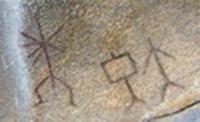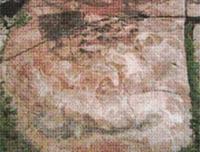You are here
Akbidayik petroglyphs.


Trips on petroglyphs Pavlodar province.
“People usually feel funny, smile and laugh when I tell them
about my strong belief in the very existence of prehistoric
advanced technology and great civilizations of wilier races.
I just can't wait to see their faces at time the truth is revealed”
Toba Beta.
Tourist travel in Kazakhstan and Uzbekistan.
Akbidayik Gorge is in the Ekiabastuz District of the Pavlodar Region, 1.5 - 2km south-east of Maykain Station. The drawings were executed on the smooth reddish surface of a large (15 - 25m) sandstone outcropping 0.5 - 0.7m above its surroundings.
The central part of the rock with petroglyphs was severely damaged by the extraction of building stones; its western part, with several spectacular compositions, is well preserved.
Akbidayik rock art was discovered in 1990 by Mertz V.K. (Pavlodar Archeological Expedition).
In 2004, the exploration of the site and a baseline documentation were carried out in partnership with Rogozhinskiy A.E. to file for state protection: an archeological map of the complex, an inventory list, indexed panorama, photos and copies from engraved surfaces were made; Iskakov K.T. (assistant of conservation specialist) studied the state of preservation of the petroglyphs and recorded damages.
More than 30 archeological sites were identified in the vicinity of the petroglyphs including dwelling-sites/workshops from the Stone Age (Lower Paleolithic, Neolithic and Eneolithic/Chalcolithic), settlements and burial sites (Bronze Age – Early Iron Age), petroglyphs as well as remnants of a railway embankment dated to the early XXth century. At Akbidayik, there are engravings from three/four stages of cultures in the north-eastern periphery of Saryarka: Neolithic, Eneolithic, Bronze and Early Iron Ages.
It is not improbable that some drawings may date to later periods. Nearly 100 petroglyphs in several groups were discovered on horizontal and inclined rock surfaces. The most expressive drawings are concentrated on the north-western surface; there are cases of superimpositions.
The most ancient petroglyphs include schematic humans with widely spread arms, legs and a pronounced phallus. Next to them are barely-discernible zoomorphic images. Some drawings are damaged due to wind erosion of the rock surface.
Petroglyphs were apparently pecked with a rough stone tool. An archer is overlaid by a horse. These drawings may date to the Stone Age. The most numerous group includes large animals realistically depicted, with a multi-figured panel including over 30 different images with large (30 – 75cm) figures of horses, Asiatic wild asses, oxen, goats, schematic humans and unidentified signs.
On the right is another group of drawings with deer and horses. Naturalistic horses are prominent in most compositions. The same technique was used to peck their silhouette regularly.
Despite the fact that many figures overlap, most were apparently created within one period in a specific order. Akbidayik horses have analogies in the eastern and south-eastern regions of Kazakhstan as well as in the Turbin-Seymin pictorial tradition at the start of the Early and Advanced Bronze Age.
In addition to these two groups of the most ancient petroglyphs at Akbidayik, there are images of bulls (Bos primigenius) with horns lowered and pointing forward, overlapping mountain goats, saiga antelopes, deer and other animals. These images date from the Eneolithic to the Early Bronze Age (3rd – early 2nd millennium BC) and to the Early Iron Age (VIIth – IVth centuries BC).
Authority:
“Rock Art Sites in Kazakhstan”. Alexey E. Rogozhinskiy.
Photos
from Panoramio Googe Map







